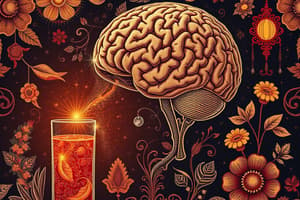Podcast
Questions and Answers
At what BAC does a person experience impairment of balance, speech, vision, reaction time, and hearing?
At what BAC does a person experience impairment of balance, speech, vision, reaction time, and hearing?
- .06 BAC
- .15 BAC
- .08 BAC (correct)
- .25 BAC
Which of the following is true about drinking and age?
Which of the following is true about drinking and age?
- It doesn't matter how young you are when you start drinking
- People who start drinking younger are more likely to become dependent on alcohol (correct)
- People who start drinking younger learn how to manage better than those who start when they are older
Which factors affect a person's BAC?
Which factors affect a person's BAC?
- Exercising while drinking
- The amount of alcohol consumed
- All (correct)
- Drinking on an empty or full stomach
What is the recommended low-risk threshold for avoiding negative health consequences from drinking?
What is the recommended low-risk threshold for avoiding negative health consequences from drinking?
How long does it typically take to metabolize a standard drink?
How long does it typically take to metabolize a standard drink?
In general, what do students and staff think about how many students drink?
In general, what do students and staff think about how many students drink?
What is the 'positive phase' of drinking?
What is the 'positive phase' of drinking?
Which of these will raise your BAC faster?
Which of these will raise your BAC faster?
Students drink for many reasons. Which of these reasons is most likely to result in negative consequences?
Students drink for many reasons. Which of these reasons is most likely to result in negative consequences?
Which of these is considered a 'standard drink?'
Which of these is considered a 'standard drink?'
What does it mean when you have a high 'tolerance' for alcohol?
What does it mean when you have a high 'tolerance' for alcohol?
What does 'alcohol blackout' mean?
What does 'alcohol blackout' mean?
Flashcards
.08 BAC
.08 BAC
Balance, speech, vision, reaction time, and hearing are impaired at this BAC.
Drinking and Age
Drinking and Age
Individuals who begin drinking at a younger age have a higher likelihood of developing alcohol dependence.
Factors Affecting BAC
Factors Affecting BAC
Multiple factors, including quantity consumed, body weight, gender, and food intake, influence a person's BAC.
Low-Risk Drinking Frequency
Low-Risk Drinking Frequency
Signup and view all the flashcards
Alcohol Metabolism Time
Alcohol Metabolism Time
Signup and view all the flashcards
Perception of Student Drinking
Perception of Student Drinking
Signup and view all the flashcards
Positive Phase of Drinking
Positive Phase of Drinking
Signup and view all the flashcards
Chugging vs. Sipping
Chugging vs. Sipping
Signup and view all the flashcards
Drinking to Cope
Drinking to Cope
Signup and view all the flashcards
Standard Drink
Standard Drink
Signup and view all the flashcards
Alcohol Tolerance
Alcohol Tolerance
Signup and view all the flashcards
Alcohol Blackout
Alcohol Blackout
Signup and view all the flashcards
Study Notes
Blood Alcohol Concentration (BAC)
- Impairment of balance, speech, vision, reaction time, and hearing begins at ~.08 BAC.
- Higher BAC levels lead to more severe impairments; ~.25 BAC is particularly dangerous.
Drinking Age and Alcohol Dependence
- Early initiation of drinking increases the risk of developing alcohol dependence.
- The assumption that young drinkers manage alcohol better than older initiators is incorrect.
Factors Affecting BAC
- Consumed alcohol quantity, type, and strength contribute to BAC rates.
- Other influencing factors include exercise during drinking, stomach fullness, birth gender, duration of drinking, body weight, and hydration efforts while drinking.
Low-Risk Drinking Recommendations
- Consuming alcohol only once a week is advised to avoid negative health consequences.
Metabolism of Alcohol
- The average time taken to metabolize a standard drink is about one hour.
Perceptions of Student Drinking
- Many perceive that more students drink than the actual numbers indicate, leading to misconceptions about alcohol use.
Positive Phase of Drinking
- The "positive phase" occurs when BAC is below ~.06, where individuals may feel lively and engaging.
Rapid BAC Increase
- Chugging drinks significantly raises BAC levels faster than drinking slowly.
Reasons for Drinking
- Coping with negative emotions is the primary reason likely to lead to adverse consequences for students.
Standard Drink Definition
- A standard drink is defined as a can of beer, roughly 12 oz, compared to larger wine glasses or multiple liquor shots.
Alcohol Tolerance
- High tolerance means individuals require more alcohol to achieve the same effects.
- Greater tolerance also correlates with a higher likelihood of withdrawal symptoms and dependence on alcohol.
Alcohol Blackout
- An alcohol blackout is characterized by being conscious yet having no memory recall of events during intoxication.
Studying That Suits You
Use AI to generate personalized quizzes and flashcards to suit your learning preferences.




